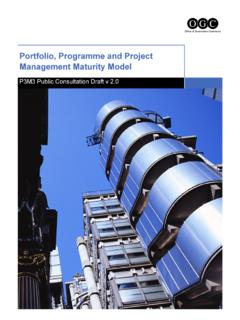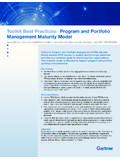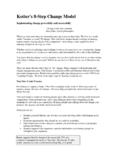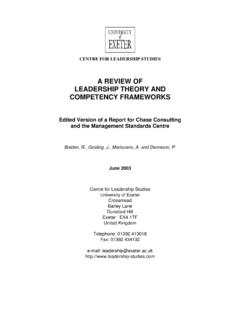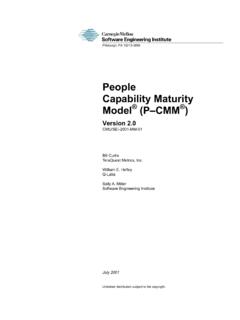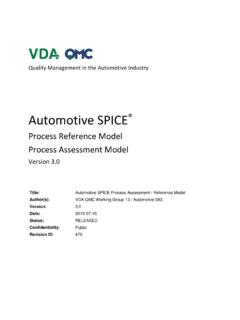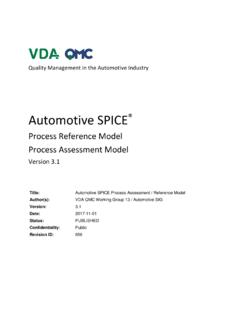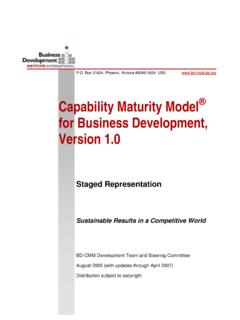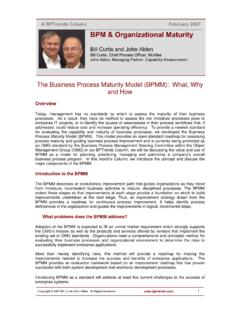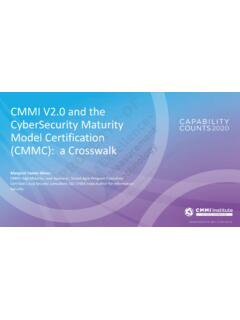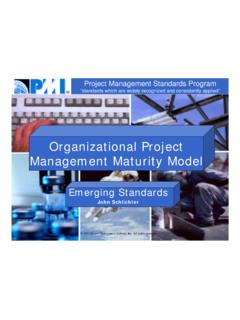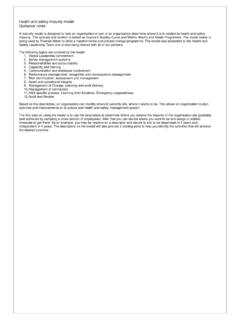Transcription of P3M3 v2.0 Self Assessment - Change Management - Practical ...
1 p3m3 Self AssessmentInstructions and questionnaire 23 Contents PageIntroduction4 User Guidance6P3M3 Self- Assessment Guidance10P3M3 model Answers28 Next Steps32 Contents4P3M3 (Portfolio, Programme and Project Management maturity model ) is an overarching model containing three individual models: JPortfolio Management maturity model (PfM3) JProgramme Management maturity model (PgM3) JProject Management maturity model (PjM3) Each model uses a five level process capability framework which may be used to gauge the overall organizational maturity . The descriptions and characteristics of the five maturity Levels apply equally to each of the three sub-models.
2 p3m3 recognizes that organizations may be excellent at project Management without embracing programme Management concepts or indeed vice versa. Similarly, an organization may be accomplished at portfolio Management while not being mature at programme Management . p3m3 focuses on seven Process Perspectives, which exist in all three models and can be assessed against five levels of capability . The flexibility of p3m3 allows organizations to review all seven Process Perspectives across all three models portfolio, programme and project Management but they can also review just one (or several) of the Process Perspectives, whether across all three models or across only one or two of them.
3 This can be useful to gain a better understanding of an organization s overall effectiveness in, for example, risk Management or resource Management . An organization may choose to view how mature it is against any or all of the sub-models, or may wish to gauge their process capability , at organizational governance across portfolio, programme or project Management . This self- Assessment tool should be read in conjunction with the p3m3 version 2 standard itself and the OGC Glossary of terms. These can be found at: Self Assessment at Glossary at of the p3m3 Self- Assessment The p3m3 Self- Assessment can be used in many ways, for example.
4 Jto provide a basic introduction and overview of the scope of p3m3 Jto gauge the current level of organizational maturity in respect of portfolio, programme and/or project Management Jto gain an understanding of the key practices in effective portfolio, programme and project Management processes Jto identify the key practices that need to be embedded within an organization for it to improve process capability and achieve the next maturity Level Jto understand and improve an organization s capability to manage its portfolio, programmes and projects more effectively.
5 The p3m3 self- Assessment questionnaire is one of a number of alternative ways for an organization to begin to explore the p3m3 model . It introduces some of the core concepts such as the five maturity Levels and seven process Perspectives that are the foundations of the completing the self- Assessment questionnaire, a relatively quick evaluation of the current organizational maturity and process capability with respect to portfolio, programme and/or project Management is obtained. Do remember though, that self-assessments tend to introduce a degree of optimism bias that is often removed through a facilitated Assessment conducted by a competent third party.
6 The self- Assessment questionnaire may be used as an introduction to the model and individuals in completing the questionnaire are encouraged to explore the p3m3 further. It may also be used as perhaps a pre-cursor to seeking further information, external consultancy, training or assistance on using p3m3 . Further information, including details of formal reviews, can be found on the official p3m3 website. It should of course be recognised that the actual p3m3 model and in particular the Attributes - indicators of process and behavioural maturity , should be referenced in drawing-up an improvement plan.
7 The p3m3 model and knowledge of where the organization needs or wants to be positioned in future, should underpin any subsequent improvement initiatives and the p3m3 model and not simply the self- Assessment questionnaire should be the basis of continuous improvement initiatives. 6 The self- Assessment consists of nine questions and although the self- Assessment is based on a few questions, it remains a powerful tool addressing both process capability and providing insight into an organization s maturity Levels in respect of portfolio, programme and project Management .
8 In completing the self- Assessment , a decision needs to be taken on whether the scope will be limited to a particular combination of portfolio, and/or programme and/or project Management . For example, an organization may wish to assess just project Management , or programme and project Management . A second decision on scope is to determine the boundary of the organization that is to be reviewed is it the whole organization or a particular division or department alone? The first question relates to the overall organizational maturity levels. The aim in answering this question is to ascertain which of the five maturity Level descriptions best describes the portfolio, programme and/or project Management processes within the organization.
9 In answering this question, users are encouraged not only to familiarize themselves with the definitions of portfolio, programme and/or project Management within Chapters 3, 4, and 5 of the p3m3 respectively, but to familiarize themselves with the characteristics which constitute best practice. The questionnaire then contains seven questions, one for each of the Perspectives contained within p3m3 covering: JManagement Control JBenefits Management JFinancial Management JStakeholder Management JRisk Management JOrganizational Governance JResource Management In completing the self- Assessment questionnaire, a user may elect to answer questions on a subset of perspectives that are perhaps of particular interest to the organization or reflect the particular user s knowledge of the organization s processes and practices.
10 A description is presented for each perspective covering five levels of process capability for portfolio and/or programme and/or project Management . The user needs to simply decide which of the five descriptions most adequately reflects the organization s current reading the descriptions, the user may conclude that the organization could be positioned within perhaps two of the Levels. In such circumstances, the user should review the specific Attributes associated with the Perspective Level descriptions within p3m3 . There are usually attributes associated with each Perspective Level and the user should review each of the specific Attributes in turn for the two Levels and consider User Guidance7whether the specific attribute is true or false in respect to current practice within the organization.
